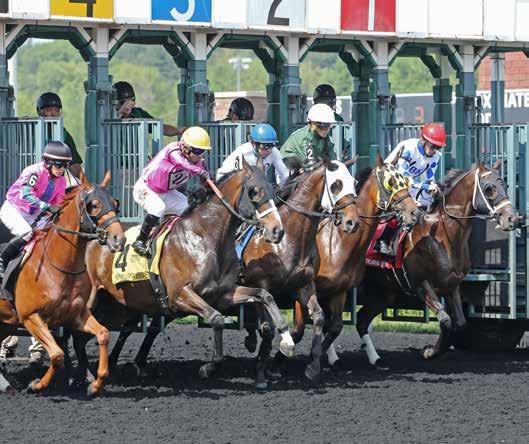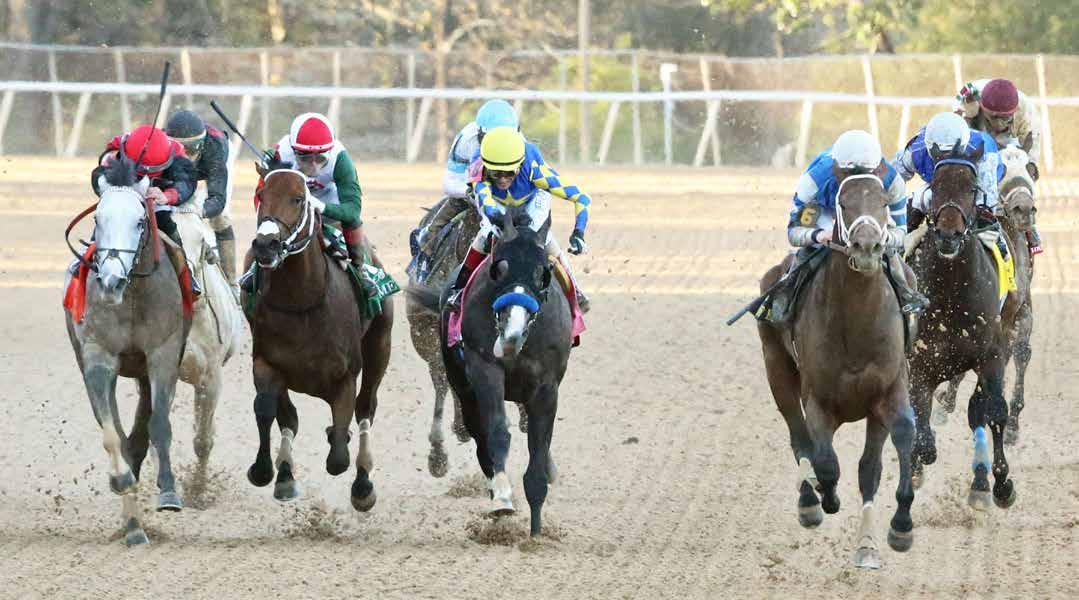
11 minute read
Nonsteroidal Anti-Inflammatories
The use of nonsteroidal anti-inflammatories (NSAIDs) in the period around a competition is almost ubiquitous in sports.
The aches and pains of high-intensity exercise are well recognized, and not a single person involved in horse racing wants their precious charges to experience discomfort for a single second longer than necessary.
The regulatory community takes the opposite stance—that pain is protective and that masking or blocking pain could actually place the equine athlete at risk of catastrophic injury. In the case of a full NSAID dose on race day, this suspicion was shown to be true in the 1990s, when horses receiving a full dose of Banamine, or flunixin, four hours before racing were at a slightly higher risk of catastrophic injuries than horses receiving other NSAIDs or no NSAIDs four hours before racing.
Of course, no jurisdiction has permitted flunixin or any other NSAID to be administered at four hours before racing for several dozen years, so this risk has long been alleviated. No studies of injured horses have subsequently shown any higher risk with the modern regulation of non-race-day administrations of NSAIDs at 24 or 48 hours.
The most common reason given by veterinarians and horsemen for administration of NSAIDs more than 24 hours before racing is to allow the horse to get a good night’s rest before the race. Like every athlete, horses have muscle soreness and tension, especially as the training pressure is ramped up coming into a race, and this pre-race treatment allows them to be fresh for the race even though there is no residual pain-relieving effect of the NSAID 24 or more hours later. Alternatively, some individual horses experience recurrent exerciseinduced rhabdomyolysis, or tying-up syndrome, and these horses require some protection to prevent tying up on a daily basis.
Threshold vs. Detection Time
Prior to the HISA medication rules going into effect, a 48-hour threshold was put in place by the Association of Racing Commissioners International (ARCI) for each of the three commonly used systemic NSAIDs: phenylbutazone, flunixin and ketoprofen.
A scientifically accurate threshold permits the rational use of a therapeutic medication at a given withdrawal point. While not completely accurate, the ARCI thresholds permitted any one of the three NSAIDs at 48 hours before racing.
The threshold was determined based on a 95 percent probability of horses administered a medication not exceeding the threshold. HISA uses similar language, but there is no statistically defined threshold determination.
Instead, a small number of horses, in some cases as few as two, are administered a drug, and the last time at which the drug is detected is determined. In the case of NSAIDs, a screening limit is used as the detection limit. If it sounds a little dicey to predict when a horse may test negative using detection times, that’s because it is.
In the case of the NSAIDs, the actual difference in threshold versus detection times is minimal. For example, even with the more predictable ARCI method of threshold determination, the 48-hour withdrawal of flunixin was never reliable.
Most veterinarians and horsemen had long thrown out any guidelines on flunixin and simply added four to six hours to the 48 hours when using flunixin. In addition to the problems with horse-to-horse variability and the inherent 1-in-20 (95 percent) probability of a positive test when relying on the ARCI threshold, flunixin is the poster child for environmental transfer risk, with a number of research papers across the globe demonstrating this effect.
In other words, the horse doesn’t even need to receive flunixin to have a positive test for the medication. The horse simply has to be put in a stall where some other horse at some time previously received flunixin. Flunixin is eliminated in the urine in exactly the same form that it is put into the horse, and it remains stable in the environment for a long time.
So, we know that we have never been able to rely on the guidelines about using flunixin at 48 hours, and there is a risk of a positive test regardless of whether it has been given to the horse or not.
What about phenylbutazone? The ARCI 48-hour threshold was 300 nanograms per milliliter (ng/mL), and the detection time for a screening limit of 200 ng/mL at 48 hours was published in the Series 4000 HISA regulations approved by the Federal Trade Commission March 23. However, on that date, HISA apparently changed this screening limit to 300 ng/mL. What this means is that most horses will still clear phenylbutazone below 300 ng/mL by 48 hours, but a few will not. As a consequence, the Racing Medication and Testing Consortium (RMTC) has made a conservative withdrawal time recommendation of 72 hours.
For the third NSAID, ketoprofen, the detection time indicated in the Series 4000 HISA regulations is 48 hours with a screening limit of 2 ng/mL for a standard 10 mL dose administered intravenously. The regulation references a study with 24 horses, but the only available study indicates that the detection time for a group of eight horses was less than 24 hours. What is unknown is at what point horses clear the detection limit of ketoprofen in the urine. This is likely longer than 24 hours. The RMTC withdrawal guidance document indicates that a safe withdrawal is 72 hours. Considering that all of the horses in the study cleared ketofen below the screening limit by 24 hours, the RMTC recommendation is likely to be highly conservative.
The HISA screening limits are effectively the same as the ARCI thresholds for phenylbutazone and ketoprofen, but it drops from 5 ng/mL to 4 ng/mL for flunixin. The RMTC withdrawal guidance on flunixin is 96 hours, effectively an added 48 hours to the previous withdrawal to cover both the uncertainty associated with the lower screening limit and possibly also the well-described random transfer of flunixin from the environment. The RMTC withdrawal guidance adds 24 hours to both phenylbutazone and ketoprofen withdrawals under the previous threshold regulations to cover the difference between a detection time and a withdrawal time. However, based on published studies of both drugs, the 72-hour withdrawal guidance is highly conservative and possibly as much as 24 hours longer than necessary for ketoprofen.
Stacking NSAIDs
A concerning change in the HISA medication rules from the previous regulatory scheme is the stacking violation for NSAIDs. Rule 3312(e)(3) states that where more than one corticosteroid or NSAID is detected in a sample, even where both are below any screening limit, there is a stacking violation.
The concerning issue with this regulation is that several NSAIDs are environmental transfer risks, as are several corticosteroids.
NONSTEROIDAL ANTI-INFLAMMATORIES ARE GIVEN BY VETERINARIANS AND HORSEMEN MORE THAN 24 HOURS BEFORE A RACE FOR SEVERAL REASONS, INCLUDING FOR MUSCLE SORENESS AND TENSION AND TO PREVENT OTHER CONDITIONS SUCH AS TYING-UP SYNDROME.
HISA also includes the valuable therapeutic dimethyl sulfoxide (DMSO) as an NSAID, an interpretation that is not supported by any science. DMSO is routinely used in a similar fashion to an NSAID in scientific studies at levels in the range of 0.1 percent up to 1 percent added to cell cultures (not actual live animals) to demonstrate various effects. However, no dose used routinely in clinical practice results in this level of DMSO.
The anti-inflammatory properties of DMSO in clinical practice stem from its protective effect against oxidative damage, similar to vitamins C and E, other antioxidants. DMSO also naturally occurs in oats, barley and legume hays like alfalfa or clover. Technically, according to Rule 3312(e)(3), a stacking violation could be called in a horse for the presence of an NSAID below its relevant screening limit and the natural occurrence of DMSO from feed sources. Since both phenylbutazone and flunixin have been identified above their respective thresholds in horses from transfer of these substances from the environment, a horse could actually have a stacking violation without receiving any NSAIDs or DMSO at all.
The background levels of DMSO in all horses, in concert with the environmental transfer concern, especially with flunixin, make treatment recommendations difficult. In theory, using the previous recommendation of 48 hours for DMSO at a dose of 60 mL diluted in a liter of intravenous fluids should not cause a violation. However, since all treatments are reported directly to HISA, such a treatment could direct the regulators to conduct special testing below the screening limits and call violations that would have never been called without the reporting.
Urine levels up to 4.5 micrograms per milliliter are naturally occurring and could potentially be called as a stacking violation, even though it had nothing to do with any DMSO that was administered.
A withdrawal recommendation on the use of DMSO requires predicting the behavior of HISA and the Horseracing Integrity and Welfare Unit rather than simply relying on science.
On the Farm: Out of Sight but Not out of Mind
With the implementation of the most recent portion of HISA, the medication regulations bring a host of problems that will catch most horsemen completely unaware.
First, Rule 3020(b) casts a wide net over who comes under the Authority’s jurisdiction. The Horseracing Integrity and Safety Act gives the private Authority jurisdiction over “covered horses, covered persons and covered horseraces.”
The new verbiage in 3020(b) extends jurisdiction to any person “undertaking the activity (activities) that makes them a Covered Person, whether or not they register with the Authority.” This disconcerting regulation means that a groom, farm worker or farm veterinarian are all subject to the HISA regulations, even if they don’t know the HISA regulations exist.
Anyone touching, treating or interacting with a covered horse is automatically subject to HISA regulations. Horses going to facilities in places like South Carolina, where many racehorses travel for layups, will be evaluated and treated by farm managers and veterinarians in ignorant bliss, not knowing what is legal and what is not. Theoretically, this overreach of HISA could extend to penalties and fines.
The scientific and veterinary advisors to the National Horsemen’s Benevolent and Protective Association and North American Association of Racetrack Veterinarians pleaded with HISA to remove valuable therapeutic medications from the banned list of medications.
While some adjustments to the banned list were made, other recommendations fell on deaf ears. In particular, two products commonly used for treatment of horses on stall rest, trazodone and fluoxetine, were left on the banned list. These medications are commonly prescribed to keep horses safe in the post-operative period, are well supported by the scientific literature and have fewer side effects than the long-term sedatives reserpine and fluphenazine, which were left on the list for our use.
It is important to understand that banning a substance on the HISA list means it cannot be used under any circumstances in a covered horse—not in the out-ofcompetition period, not post-surgery to prevent a horse from damaging its surgical site, not at all. Add this to the fact that a farm veterinarian or manager completely unaware of this regulation could readily treat a horse with these medications and inadvertently subject the owner and trainer to fines and suspensions as well as potentially prevent the horse from racing for up to 14 months.
No-Lasix Racing
American horsemen have long been spoiled in that, for many years, we have not had to deal with the severe respiratory sequela to exercise-induced pulmonary hemorrhage (EIPH). Before the widespread use of Lasix to mitigate EIPH, horsemen were accustomed to dealing with the aftermath of bleeding into the lungs. Sudden deaths in racehorses are rare in all jurisdictions, but when they occur in countries where Lasix is not permitted, the most common cause is severe EIPH.
The hemorrhage that occurs with EIPH is predominantly in the dorsocaudal lungs field, or the top back portion of the lungs. This is the region of the lung that experiences the highest pulmonary blood pressure during high-intensity exercise. With each heartbeat, half of a horse’s entire blood volume passes through the working muscles, and the other half passes through the lungs. Horses are so efficient at moving blood across the lung field that they do not fully oxygenate their blood when they are at maximal exercise. The equine is unique among species in this phenomenon, which is part of the reason horses are exceptional athletes.

The pressure is so great that essentially all racehorses bleed into their lungs at one time or another during competition. As the pressure mounts, the integrity of the capillary walls fails, and blood passes through the broken capillaries into the alveoli of the lungs. Small amounts of this failure are inconsequential, but as more and more capillaries are breached, the damage to the lungs can be substantial. Healing occurs by fibrosis, making the lungs less compliant and increasing the chances of worse bleeding with subsequent episodes.

Other than the chronic, progressive lung damage, more sinister sequela to EIPH have been well described.
In the absence of Lasix to mitigate EIPH, pleuropneumonia, a lifethreatening infection of the lungs and thoracic cavity after EIPH, is well described. When substantial blood crosses the broken capillaries into the airways, it can settle into the ventral (bottom) portions of the lungs and become infected with bacteria that the horse is unable to clear.
Abscesses form in the lungs that can then break into the thoracic cavity. The lack of a good blood supply to this structure makes this type of infection very difficult to clear. In the years before widespread use of Lasix in racing, racehorses with pleuropneumonia were commonplace at referral facilities in this country. A study in Venezuela reviewed all horses that died at La Rinconada racetrack over a three-year period. In that review, 29 horses that raced without Lasix died because of pleuritis/pleuropneumonia, and an additional 15 horses had pneumonia or pulmonary abscesses as a complication of EIPH.
With the current HISA restrictions on Lasix in both stakes races and 2-year-old races and a permanent HISA-related prohibition on Lasix in all U.S. racing on the horizon in the next few years, horsemen and veterinarians need to be on the lookout for these new health problems we are already beginning to see.

In addition to using Lasix to mitigate EIPH, the therapeutic bronchodilator Ventipulmin (clenbuterol) has been commonly used in the post-race period for the purpose of helping the horse to remove the blood and racetrack particulates from the airways after racing. Severe restrictions on clenbuterol have made this practice essentially banned. There are few alternatives to clenbuterol for this purpose.
Protecting the Health and Welfare of Our Horses
The HISA therapeutic medication restrictions that ban appropriate care of our horses will make maintaining their health and welfare more complicated. Close and careful monitoring of horses after racing for signs of respiratory disease is critical. Endoscopy after racing to detect EIPH in every horse racing without Lasix is critical. While most horses that bleed show signs, such as swallowing during the coolout period, refusing to drink water, rapid breathing or coughing after racing, not all horses that bleed show these signs. Endoscopy remains our best diagnostic procedure to detect EIPH. Inhaled albuterol is considerably less effective than clenbuterol for moving blood out of the airways, but that may be our only option. Antibiotics to prevent infection of the bloody exudate are warranted in most cases of EIPH.
Ultrasound examination of the caudodorsal thoracic region can show evidence of EIPH both in the immediate post-race period, and once infection takes hold, ultrasound of the cranioventral (bottom) portion of the lungs is necessary to detect pulmonary abscesses, pleuritis and pleuropneumonia. Complete blood counts may be useful but are often unremarkable in these cases. Racetrack practitioners are already seeing these problems in horses racing without Lasix, and every horseman needs to be aware that the incidence of EIPH sequela is on the rise.
Unfortunately, HISA has many of the therapeutic medications that we have used to mitigate EIPH over and above Lasix, such as aminocaproic acid (Amicar), ergonovine derivatives and tranexamic acid, listed as either banned or associated with such prolonged withdrawals that they cannot be used.
Protecting the health and welfare of our racehorses has become extremely difficult in the new world order of HISA. HJ











